Dragoon
Dragoons originally were a class of mounted infantry, who used horses for mobility, but dismounted to fight on foot. From the early 17th century onward, dragoons were increasingly also employed as conventional cavalry, trained for combat with swords from horseback.[1]
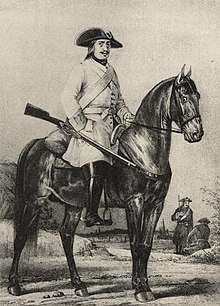
Dragoon regiments were established in most European armies during the late 17th and early 18th centuries.
The name is derived from a type of firearm, called a "dragon", which was a handgun version of a blunderbuss, carried by dragoons of the French Army.[2][3]
The title has been retained in modern times by a number of armoured or ceremonial mounted regiments.
Origins and name

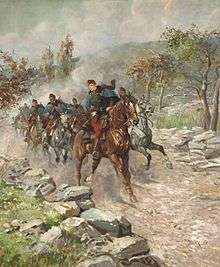
The establishment of dragoons evolved from the practice of sometimes transporting infantry by horse when speed of movement was needed. In 1552 Prince Alexander of Parma mounted several companies of infantry on pack horses to achieve surprise.[4] Another early instance was ordered by Louis of Nassau in 1572 during operations near Mons in Hainaut, when 500 infantry were transported this way.[4] It is also suggested the first dragoons were raised by the Marshal de Brissac in 1600.[5] According to old German literature, dragoons were invented by Count Ernst von Mansfeld, one of the greatest German military commanders, in the early 1620s. There are other instances of mounted infantry predating this. However Mansfeld, who had learned his profession in Hungary and the Netherlands, often used horses to make his foot troops more mobile, creating what was called an "armée volante" (French for flying army).
In the 16th century Spanish civil wars in Peru conquistadors fought on horse with arquebuses, prefiguring the origin of European dragoons.[6]
The name possibly derives from an early weapon, a short wheellock called a dragon, because the first dragoons raised in France had their carbine's muzzle decorated with a dragon's head. The practice comes from a time when all gunpowder weapons had distinctive names, including the culverin, serpentine, falcon, falconet, etc.[7] It is also sometimes claimed a galloping infantryman with his loose coat and the burning match resembled a dragon.[8]
It has also been suggested that the name derives from the German "tragen" or the Dutch "dragen", both being the verb "to carry" in their respective languages. Howard Reid claims that the name and role descend from the Latin Draconarius.[9]
Use as a verb
Dragoon is occasionally used as a verb to mean to subjugate or persecute by the imposition of troops; and by extension to compel by any violent measures or threats. The term dates from 1689, at a time when dragoons were being used by the French monarchy to persecute Protestants, particularly by forcing Protestants to lodge a dragoon in their house to watch over them, at the householder's expense.[10]
Early history and role
Early dragoons were not organized in squadrons or troops as were cavalry, but in companies like the infantry: their officers and non-commissioned officers bore infantry ranks. Dragoon regiments used drummers, not buglers, to communicate orders on the battlefield. The flexibility of mounted infantry made dragoons a useful arm, especially when employed for what would now be termed "internal security" against smugglers or civil unrest, and on line of communication security duties. During the English Civil War dragoons were used for a variety of tasks: providing outposts, holding defiles or bridges in the front or rear of the main army, lining hedges or holding enclosures, and providing dismounted musketeers to support regular cavalry.[11]. In the closing stages of the Battle of Naseby Okey's Dragoons, who had started the action as dismounted musketeers, got on their horses and charged, possibly the first time this was done. Supplied with inferior horses and more basic equipment, the dragoon regiments were cheaper to recruit and maintain than the expensive regiments of cavalry. When in the 17th century Gustav II Adolf introduced dragoons into the Swedish Army, he provided them with a sabre, an axe and a matchlock musket, utilizing them as "labourers on horseback".[12] Many of the European armies henceforth imitated this all-purpose set of weaponry.
A non-military use of dragoons was the 1681 Dragonnades, a policy instituted by Louis XIV to intimidate Huguenot families into either leaving France or re-converting to Catholicism by billeting ill-disciplined dragoons in Protestant households. While other categories of infantry and cavalry were also used, the mobility, flexibility and available numbers of the dragoon regiments[13] made them particularly suitable for repressive work of this nature over a wide area.
In the Spanish Army, Pedro de la Puente organized a body of dragoons in Innsbruck in 1635. In 1640, a tercio of a thousand dragoons armed with the arquebus was created in Spain. By the end of the 17th century, the Spanish Army had three tercios of dragoons in Spain, plus three in the Netherlands and three more in Milan. In 1704, the Spanish dragoons were reorganised into regiments by Philip V, as were the rest of the tercios.
Towards the end of 1776, George Washington realized the need for a mounted branch of the American military. In January 1777 four regiments of light dragoons were raised. Short term enlistments were abandoned and the dragoons joined for three years, or "the war". They participated in most of the major engagements of the American War of Independence, including the Battles of White Plains, Trenton, Princeton, Brandywine, Germantown, Saratoga, Cowpens, and Monmouth, as well as the Yorktown campaign.
Dragoons were at a disadvantage when engaged against true cavalry, and constantly sought to improve their horsemanship, armament and social status. By the Seven Years' War the primary role of dragoons in most European armies had progressed from that of mounted infantry to that of heavy cavalry.[14] Earlier dragoon responsibilities for scouting and picket duty had passed to hussars and similar light cavalry corps in the French, Austrian, Prussian, and other armies. In the Imperial Russian Army, due to the availability of the Cossack troops, the dragoons were retained in their original role for much longer.
An exception to the rule was the British Army. To reduce military budgets, all horse (cavalry) regiments were gradually demoted to dragoons from 1746 onward — which meant they were paid on a lower scale. When this was completed in 1788, the heavy cavalry regiments had become either Dragoon Guards or Heavy Dragoons (depending on their precedence). The designation of Dragoon Guards did not mean that these regiments (the former 2nd to 8th Horse) had become Household Troops, but simply that they had been given a more dignified title to compensate for the loss of pay and prestige.[15] Starting in 1756, seven regiments of Light Dragoons were raised. These Light Dragoons were trained in reconnaissance, skirmishing and other work requiring endurance in accordance with contemporary standards of light cavalry performance. The success of this new class of cavalry was such that eight regular Dragoon regiments were converted to Light Dragoons between 1768 and 1783.[16]
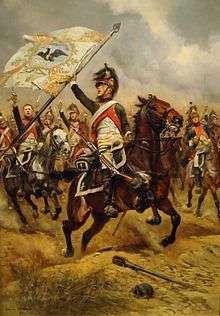
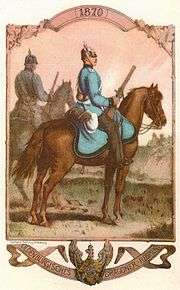
19th century
During the Napoleonic Wars, dragoons generally assumed a cavalry role, though remaining a lighter class of mounted troops than the armored cuirassiers. Dragoons rode larger horses than the light cavalry and wielded straight, rather than curved swords. Emperor Napoleon often formed complete divisions out of his 30 dragoon regiments[17] and used them as battle cavalry to break the enemy's main resistance.[18][19] In 1809, French dragoons scored notable successes against Spanish armies at the Battle of Ocana and the Battle of Alba de Tormes.
British heavy dragoons made devastating charges against French infantry at the Battle of Salamanca in 1812 and at the Battle of Waterloo in 1815. 31 regiments were in existence at the height of the Napoleonic Wars: seven Dragoon Guards regiments[20] and 24 cavalry of the line regiments.[21] The Dragoon Guards and Dragoon regiments were the heavy cavalry regiments of the British Army, although by continental standards they were not the heaviest type of cavalry since they carried no armour (unlike cuirassiers).[22] While some of the cavalry regiments of the line were simply designated as regiments of dragoons, the lighter cavalry regiments, which were particularly mobile, became regiments of Light Dragoons, employing the 1796-pattern light cavalry sabres.[23] From 1805 four regiments of Light Dragoons were designated Hussars (7th, 10th, 15th and 18th Regiments), differentiated by uniform, and the wearing of mustaches. After the end of the Napoleonic Wars (starting in 1816) some regiments became lancers, identified by the lances that they carried.[24]
The creation of a unified German state in 1871 brought together the dragoon regiments of Prussia, Bavaria, Saxony, Mecklenburg, Oldenburg, Baden, Hesse and Württemberg in a single numbered sequence, although historic distinctions of insignia and uniform were largely preserved. Two regiments of the Imperial Guard were designated as dragoons.[25]
The Austrian (later Austro-Hungarian) Army of the 19th century included six regiments of dragoons in 1836, classed as heavy cavalry for shock action, but in practice used as medium troops[26] with a variety of roles. After 1859 all but two Austrian dragoon regiments were converted to cuirassiers or disbanded.[27] From 1868 to 1918 the Austro-Hungarian dragoons numbered 15 regiments.[28]
During the 18th century several regiments of dragoons were created in Spain's American viceroyalties to protect the northern provinces and borders of New Spain in the present-day states of California, Nevada, Colorado, Texas, Kansas, Arizona, Montana, North Dakota and South Dakota.[29] Some of these functioned as a police force. In 1803, the regiments of dragoons began to be called light cavalry (Cazadores) and dragoons disappeared from the Spanish Army shortly after 1815.
In New Spain, soon to be México, dragoons were important and elite units of the Royal Army. A number of dragoons became important military and political figures, among them Ignacio Allende and Juan Aldama, members of the Queen's Regiment of Dragoons who defected and then initiated the independence movement in México in 1810. Another important dragoon was Agustin de Iturbide, who would ultimately achieve Mexican independence in 1821. He was known as the greatest horseman in México and became so renowned in battle during his youth that he acquired the nickname El Dragón de Hierro or "The Iron Dragon" (in Spanish, "dragon" and "dragoon" both sound and are written exactly the same). He would go on to become Agustín I, after being elected Emperor of México. The political importance of dragoons during this time in the nascent country cannot be overstated.
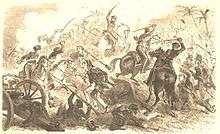
Prior to the War of 1812 the U.S. organized the Regiment of Light Dragoons. For the war a second regiment was activated; that regiment was consolidated with the original regiment in 1814. The original regiment was consolidated with the Corps of Artillery in June 1815.[30]
The 1st United States Dragoons explored Iowa after the Black Hawk Purchase put the area under U.S. control. In the summer of 1835, the regiment blazed a trail along the Des Moines river and established outposts from present-day Des Moines to Fort Dodge. In 1933, the State of Iowa opened the Dragoon Trail, a scenic and historic drive that follows the path of the 1st United States Dragoons on their historic march.
In 1861 the two existing U.S. Dragoon regiments were re-designated as the 1st and 2nd Cavalry. This reorganization did not affect their role or equipment, although the traditional orange uniform braiding of the dragoons was replaced by the standard yellow of the Cavalry branch. This marked the official end of dragoons in the U.S. Army, although certain modern units trace their origins back to the historic dragoon regiments.
In several stages between 1816 and 1861, the 21 existing Light Dragoon regiments in the British Army were disbanded or converted to lancers or hussars.[31]
Between 1881 and 1907 all Russian cavalry (other than Cossacks and Imperial Guard regiments) were designated as dragoons, reflecting an emphasis on the double ability of dismounted action as well as the new cavalry tactics in their training and a growing acceptance of the impracticality of employing historical cavalry tactics against modern firepower. Upon the reinstatement of Uhlan and Hussar Regiments in 1907 their training pattern, as well as that of the Cuirassiers of the Guard, remained unchanged until the collapse of the Russian Imperial Army.[32]
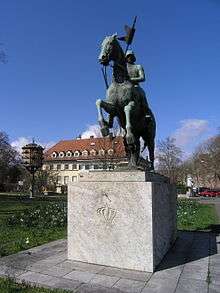
In Japan, in the late 19th century/early 20th century, dragoons were deployed in the same way as in other armies, but were dressed as hussars.
20th century
In 1914 there were still dragoon regiments in the British, French,[33] German, Russian, Austro-Hungarian,[34] Peruvian, Norwegian, Swedish, Danish and Spanish armies. Their uniforms varied greatly, lacking the characteristic features of hussar or lancer regiments. There were occasional reminders of the mounted infantry origins of this class of soldier. Thus the 28 dragoon regiments of the Imperial German Army wore the Pickelhaube (spiked helmet) of the same design as those of the infantry[35] and the British dragoons wore scarlet tunics for full dress while hussars and all but one of the lancer regiments wore dark blue.[36] In other respects however dragoons had adopted the same tactics, roles and equipment as other branches of the cavalry and the distinction had become simply one of traditional titles. Weaponry had ceased to have a historic connection, with both the French and German dragoon regiments carrying lances during the early stages of World War I.
The historic German, Russian and Austro-Hungarian dragoon regiments ceased to exist as distinct branches following the overthrow of the respective imperial regimes of these countries during 1917–18. The Spanish dragoons, which dated back to 1640, were reclassified as numbered cavalry regiments in 1931 as part of the army modernization policies of the new republic.
The Australian Light Horse were similar to 18th-century dragoon regiments in some respects, being mounted infantry which normally fought on foot, their horses' purpose being transportation. They served during the Second Boer War and World War I. The Australian 4th Light Horse Brigade became famous for the Battle of Beersheba in 1917 where they charged on horseback using rifle bayonets, since neither sabres or lances were part of their equipment. Later in the Palestine campaign Pattern 1908 Cavalry Swords were issued and used in the campaign leading to the fall of Damascus.
Probably the last use of real dragoons (infantry on horseback) in combat was made by the Portuguese Army in the war in Angola during the 1960s and 1970s. In 1966, the Portuguese created an experimental horse platoon, to operate against the guerrillas in the high grass region of Eastern Angola, in which each soldier was armed with a G3 assault rifle for combat on foot and with an automatic pistol to fire from horseback. The troops on horseback were able to operate in difficult terrain unsuited to motor vehicles and had the advantage of being able to control the area around them, with a clear view over the grass that foot troops did not have. Moreover, these unconventional troops created a psychological impact on an enemy that was not used to facing horse troops, and thus had no training or strategy to deal with them. The experimental horse platoon was so successful that its entire parent battalion was transformed from an armored reconnaissance unit to a three-squadron horse battalion known as the "Dragoons of Angola". One of the typical operations carried out by the Dragoons of Angola, in cooperation with airmobile forces, consisted of the dragoons chasing the guerrillas and pushing them in one direction, with the airmobile troops being launched from helicopter in the enemy rear, trapping the enemy between the two forces.[37]
Dragoner rank
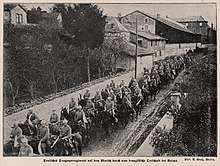
Until 1918 Dragoner (en: dragoon) was the designation given to the lowest ranks in the dragoon regiments of the Austro-Hungarian and Imperial German Armies. The Dragoner rank, together with all other private ranks of the different branch of service, did belong to the so-called gemeine rank group.
Modern dragoons
Brazil
The Brazilian president's honor guard is provided (amongst other units) by a regiment of dragoons: the 1st Guards Cavalry Regiment of the Brazilian Army.
This regiment is known as the "Dragões da Independência" (Independence Dragoons). The name was given in 1927 and refers to the fact that a detachment of dragoons escorted the Prince Royal of Portugal, Pedro I, at the time when he declared Brazilian independence from Portugal, on September 7, 1822.
The Independence Dragoons wear 19th-century dress uniforms similar to those of the earlier Imperial Honor Guard, which are used as the regimental full dress uniform since 1927. The uniform was designed by Debret, in white and red, with plumed bronze helmets. The colors and pattern were influenced by the Austrian dragoons of the period, as the Brazilian Empress Consort was also an Austrian Archduchess.[38] The color of the plumes varies according to rank. The Independence Dragoons are armed with lances and sabres, the latter only for the officers and the colour guard.[39]
The regiment was established in 1808 by the Prince Regent and future king of Portugal, John VI, with the duty of protecting the Portuguese royal family, which had sought refuge in Brazil during the Napoleonic wars. However dragoons had existed in Portugal since at least the early 18th century and, in 1719, units of this type of cavalry were sent to Brazil, initially to escort shipments of gold and diamonds and to guard the Viceroy who resided in Rio de Janeiro (1st Cavalry Regiment – Vice-Roy Guard Squadron). Later, they were also sent to the south to serve against the Spanish during frontier clashes. After the proclamation of Brazilian independence, the title of the regiment was changed to that of the Imperial Honor Guard, with the role of protecting the Imperial Family. The Guard was later disbanded by Emperor Peter II and would be recreated only later in the republican era.[40]
At the time of the Republic proclamation in 1889, horse #6 of the Imperial Honor Guard was ridden by the officer making the declaration of the end of Imperial rule, Second Lieutenant Eduardo José Barbosa. This is commemorated by the custom under which the horse having this number is used only by the commander of the modern regiment.
Canada
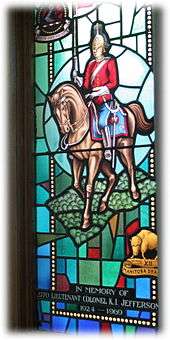
There are three dragoon regiments in the Canadian Forces: the Royal Canadian Dragoons and two reserve regiments, the British Columbia Dragoons and the Saskatchewan Dragoons. The Royal Canadian Dragoons is the senior Armoured regiment in the Canadian Forces. The current role of The Royal Canadian Dragoons is to provide Armour Reconnaissance support to 2 Canadian Mechanized Brigade Group (2 CMBG) operations.
The Royal Canadian Mounted Police were accorded the formal status of a regiment of dragoons in 1921.[41][42] The modern RCMP does not retain any military status however.
Chile
Founded as the Dragones de la Reina (Queen's Dragoons) in 1758 and later renamed the Dragoons of Chile in 1812, and then becoming the Carabineros de Chile in 1903. The Carabineros are the national police of Chile. The military counterpart, that of the 15th Reinforced Regiment "Dragoons" is now as of 2010 the 4th Armored Brigade "Chorrillos" based in Punta Arenas as the 6th Armored Cavalry Squadron "Dragoons", and form part of the 5th Army Division.
Denmark
The Royal Danish Army includes amongst its historic regiments the Jutish Dragoon Regiment, which was raised in 1670.
France
The modern French Army retains three dragoon regiments from the thirty-two in existence at the beginning of World War I: the 2nd, which is a nuclear, biological and chemical protection regiment, the 5th, an experimental Combined arms regiment, and the 13th (Special Reconnaissance).
Lithuania
Beginning in the 17th century, the mercenary army of the Grand Duchy of Lithuania included dragoon units. In the middle of the 17th century there were 1,660 dragoons in an army totaling 8,000 men. By the 18th century there were four regiments of dragoons.
Lithuanian cavalrymen served in dragoon regiments of both the Russian and Prussian armies, after the Partitions of the Polish–Lithuanian Commonwealth.
Between 1920–1924 and 1935–1940 the Lithuanian Army included the Third Dragoon Iron Wolf Regiment. The dragoons were the equivalent of the present-day Volunteer Forces.
In modern Lithuania the Grand Duke Butigeidis Battalion (Lithuanian: didžiojo kunigaikščio Butigeidžio dragūnų batalionas)[43] is designated as dragoons, with a motorized infantry role.
Norway
In the Norwegian Army during the early part of the 20th century, dragoons served in part as mounted troops, and in part on skis or bicycles (hjulryttere, meaning "wheel-riders"). Dragoons fought on horses, bicycles and skis against the German invasion in 1940. After World War II the dragoon regiments were reorganized as armoured reconnaissance units. "Dragon" is the rank of a compulsory service private cavalryman while enlisted (regular) cavalrymen have the same rank as infantrymen: "Grenader".
Peru
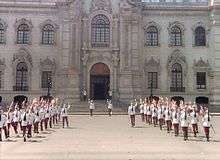
The Presidential Escort Life Guard Dragoons Regiment "Field Marshal Domingo Nieto", named after Field Marshal Domingo Nieto, of the President of the Republic of Perú were the traditional Guard of the Government Palace of Perú until March 5, 1987 and its disbandment in that year. However, by Ministerial Resolution No 139-2012/DE/EP of February 2, 2012 the restoration of the Cavalry Regiment "Marshal Domingo Nieto" as the official escort of the President of the Republic of Peru was announced. The main mission of the reestablished regiment was to guarantee the security of the President of the Republic and of the Government Palace.
This regiment of dragoons was created in 1904 following the suggestion of a French military mission which undertook the reorganization of the Peruvian Army in 1896. The initial title of the unit was Cavalry Squadron "President's Escort". It was modelled on the French dragoons of the period. The unit was later renamed as the Cavalry Regiment "President's Escort" before receiving its current title in 1949.
The Peruvian Dragoon Guard has throughout its existence worn French-style uniforms of black tunic and red breeches in winter and white coat and red breeches in summer, with red and white plumed bronze helmets with the coat of arms of Peru and golden or red epaulettes depending on rank. They retain their original armament of lances and sabres, until the 1980s rifles were used for dismounted drill.
At 13:00 hours every day, the main esplanade in front of the Government Palace of Perú fronting Lima's Main Square serves as the stage for the changing of the guard, undertaken by members of the Presidential Life Guard Escort Dragoons, mounted or dismounted. While the dismounted changing is held on Mondays and Fridays, the mounted ceremony is held twice a month on a Sunday.
Portugal
The Portuguese Army still maintains two units which are descended from former regiments of dragoons. These are the 3rd Regiment of Cavalry (the former "Olivença Dragoons") and the 6th Regiment of Cavalry (the former "Chaves Dragoons"). Both regiments are, presently, armoured units. The Portuguese Rapid Reaction Brigade' Armoured Reconnaissance Squadron – a unit from the 3rd Regiment of Cavalry – is known as the "Paratroopers Dragoons".
During the Portuguese Colonial War in the 1960s and the 1970s, the Portuguese Army created an experimental horse platoon, to combat the guerrillas in eastern Angola. This unit was soon augmented, becoming a group of three squadrons, known as the "Angola Dragoons". The Angola Dragoons operated as mounted infantry – like the original dragoons – each soldier being armed with a pistol to fire when on horseback and with an automatic rifle, to use when dismounted. A unit of the same type was being created in Mozambique when the war ended in 1974.
Spain
The Spanish Army began the training of a dragoon corps in 1635 under the direction of Pedro de la Puente at Innsbruck. In 1640 the first dragoon "tercio" was created, equipped with arquebuses and maces. The number of dragoon tercios was increased to nine by the end of the XVII century: three garrisoned in Spain, another three in the Netherlands and the remainder in Milan.[44]
The tercios were converted into a regimental system, beginning in 1704. Philip V created several additional dragoon regiments to perform the functions of a police corps in the New World.[45] Notable amongst those units were the leather-clad dragones de cuera.
In 1803 the dragoon regiments were renamed as "caballería ligera" (light cavalry). By 1815 these units had been disbanded.[46]
Spain recreated its dragoons in the late nineteenth century. In 1930, three Spanish dragoon regiments were still in existence.[47]
Sweden
In the Swedish Army, dragoons comprise the Military Police and Military Police Rangers. They also form the 13th Battalion of the Life Guards, which is a military police unit. The 13th (Dragoons) Battalion have roots that go back as far as 1523, making it one of the world's oldest military units still in service. Today, the only mounted units still retained by the Swedish Army are the two dragoons squadrons of the King's Guards Battalion of the Life Guards. Horses are used for ceremonial purposes only, most often when the dragoons take part in the changing of the guards at The Royal Palace in Stockholm. "Livdragon" is the rank of a private cavalryman.
Switzerland
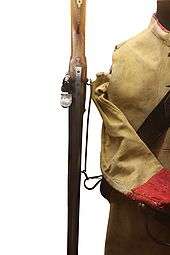
In the Swiss Army, mounted dragoons existed until the early 1970s, when they were converted into Armoured Grenadiers units. The "Dragoner" had to prove he was able to keep a horse at home before entering the army. At the end of basic training they had to buy a horse at a reduced price from the army and to take it home together with equipment, uniform and weapon. In the "yearly repetition course" the dragoons served with their horses, often riding from home to the meeting point.
The abolition of the dragoon units, believed to be the last non-ceremonial horse cavalry in Europe, was a contentious issue in Switzerland. On 5 December 1972 the Swiss National Council approved the measure by 91 votes, against 71 for retention.[48]
United Kingdom
In the present-day British Army regular army, four regiments are designated as dragoons: The 1st The Queen's Dragoon Guards, The Royal Scots Dragoon Guards, the Royal Dragoon Guards, and the Light Dragoons. In the Territorial Army, one of the five squadrons of the Royal Yeomanry—the Westminster Dragoons— also has the title of dragoons.
United States
The 1st and 2nd Battalion, 48th Infantry were mechanized infantry units assigned to the 3rd Armored Division (3AD) in West Germany during the Cold War. The unit crest of the 48th Infantry designated the unit as Dragoons, purely a traditional designation.
The 1st Dragoons was reformed in the Vietnam War era as the 1st Squadron, 1st U.S. Cavalry. It served in the Iraq War and remains as the oldest cavalry unit, as well as the most decorated one, in the U.S. Army. Today's modern 1–1 Cavalry is a scout/attack unit, equipped with MRAPs, M3A3 Bradley CFVs, and Strykers.[49]
Another modern United States Army unit, informally known as the 2nd Dragoons, is the 2nd Cavalry Regiment. This unit was originally organized as the Second Regiment of Dragoons in 1836 and was renamed the Second Cavalry Regiment in 1861, being redesignated as the 2nd Armored Cavalry Regiment in 1948. The regiment is currently equipped with the Stryker family of wheeled fighting vehicles and was redesignated as the 2nd Stryker Cavalry Regiment in 2006. In 2011 the 2nd Dragoon regiment was redesignated as the 2nd Cavalry Regiment. The 2nd Cavalry Regiment has the distinction of being the longest continuously serving regiment in the United States Army.[50]
The 113th Army Band at Fort Knox is also officially nicknamed as "The Dragoons." This derives from its formation as the Band, First Regiment of Dragoons on July 8, 1840.
Company D, 3rd Light Armored Reconnaissance Battalion of the United States Marine Corps, is nicknamed the "Dragoons". Their combat history includes Operation Iraqi Freedom and Operation Enduring Freedom from 2002 to 2013.[51]
Citations and notes
- Carman, W.Y. A Dictionary of Military Uniform. p. 48. ISBN 0-684-15130-8.
- "Dragoon". Oxford English Dictionary.
A kind of carbine or musket.
- "took his name from his weapon, a species of carbine or short musket called the dragon" (Chisholm, Hugh, ed. (1911). . Encyclopædia Britannica. 8 (11th ed.). Cambridge University Press. p. 471.)
- p. 330, Bismark
- p. 331, Bismark
- Espino López, Antonio (2012). "El uso táctico de las armas de fuego en las guerras civiles peruanas (1538-1547)". Historica (in Spanish). XXXVI (2): 7–48.
- p. 333, Bismark
- p. 48, A Dictionary of Military Uniform W. Y. Carman ISBN 0-684-15130-8
- p96, Arthur the Dragon King – The Barbaric Roots of Britain's Greatest Legend, Howard Reid, ISBN 0-7472-7558-0
- "the definition of dragoon". Dictionary.com.
- Peter Young & Richard Holmes, page 42 "The English Civil War", ISBN 1-84022-222-0
- Richard Brzezinski, page 16 "The Army of Gustavus Adolphus 2 - ", ISBN 1-85532-350-8
- Chartrand, Rene. Louis XIV's Army. p. 37. ISBN 0-85045-850-1.
- Dragoons are sometimes described as 'medium' cavalry, midway between heavy/armoured and light regiments, though this was a classification that was rarely given at the time. page 19 "Napoleonic Cavalry", Philip Haythornthwaite, ISBN 0-304-35508-9
- Michael Barthorp, page 22 "British Cavalry Uniforms Since 1660", ISBN 0-7137-1043-8
- page 24 "British Cavalry Uniforms Since 1660", Michael Barthorp, ISBN 0-7137-1043-8
- In 1811 six regiments were converted to Chevau-Legers Lanciers
- Rothenberg, p. 141
- In northern and eastern Europe they were employed as heavy cavalry, while in the Iberian peninsula they fulfilled, in addition, the role of lighter cavalry, for example in anti-guerrilla operations. page 19 "Napoleonic Cavalry", Philip Haythornthwaite, ISBN 0-304-35508-9
- The seven Dragoon Guards regiments were the 1st (King's) Dragoon Guards, 2nd Dragoon Guards (Queen's Bays), 3rd (Prince of Wales's) Dragoon Guards, 4th (Royal Irish) Dragoon Guards, 5th (Princess Charlotte of Wales's) Dragoon Guards, 6th Dragoon Guards (Carabiniers) and the 7th (Princess Royal's) Dragoon Guards.
- The 24 cavalry of the line regiments were the 1st (Royal) Dragoons, the 2nd Dragoons (Royal Scots Greys), the 3rd (King's Own) Hussars, the 4th (Queen's Own) Hussars, the 5th (Royal Irish) Lancers (disbanded in 1799 and reformed in 1858), the 6th (Inniskilling) Dragoons, the 7th (Queen's Own) Hussars, the 8th (King's Royal Irish) Hussars, the 9th (Queen's Royal) Lancers, the 10th (Prince of Wales's Own Royal) Hussars, the 11th (Prince Albert's Own) Hussars, the 12th (Prince of Wales's Royal) Lancers, the 13th Hussars, the 14th (King's) Hussars, the 15th (The King's) Hussars, the 16th (The Queen's) Lancers, the 17th (Duke of Cambridge's Own) Lancers, the 18th (Queen Mary's Own) Royal Hussars, the 19th (Queen Alexandra's Own Royal) Hussars, the 20th Hussars, the 21st (Empress of India's) Lancers, the 22nd (Light) Dragoons, the 23rd Light Dragoons, the 24th Regiment of (Light) Dragoons and the 25th Dragoons (renumbered as the 22nd Dragoons in 1802).
- Rowe, David (2004). Head dress of the British heavy cavalry: Dragoon Guards, Household and Yeomanry Cavalry. Schiffer Publishing. ISBN 978-0-7643-0957-1.
- Kannik, Prebben (1968), Military Uniforms in Colour, Blandford Press, ISBN 0-7137-0482-9 (p. 200)
- "Saddle, lance and stirrup". Classical fencing. Archived from the original on 23 August 2012. Retrieved 9 August 2016.
- Marrion, R.J. Lancers and Dragoons. pp. 7–11. ISBN 0-85524-201-9.
- Pavlovic, Darko. The Austrian Army 1836–66 (2) Cavalry. p. 3. ISBN 1-85532-800-3.
- Pavlovic, Darko. The Austrian Army 1836–66 (2) Cavalry. p. 4. ISBN 1-85532-800-3.
- Knotel, Richard. Uniforms of the World. p. 26. ISBN 0-684-16304-7.
- Torres, Fernando Martínez Láinez, Carlos Canales (2008). Banderas lejanas: la exploración, conquista y defensa por España del territorio de los actuales Estados Unidos (1st ed.). Madrid: Edaf. ISBN 9788441421196.
- Heitman pp. 79—80
- British Cavalry Uniforms Since 1660, Michael Barthorp ISBN 0-7137-1043-8
- Cavalry/Encyclopaedia Militera. Editor-in-Chief Gen. Stuff Colonel N. F. Novitsky. V.11. Moscow – SPb, Sytin Publishing, 1911–1915
- Jouineau, Andre. Officers and Soldiers of the French Army 1914. pp. 23–25. ISBN 978-2-35250-104-6.
- Lucas, James. Fighting Troops of the Austro-Hungarian Army 1868-1914. pp. 101–105. ISBN 0-946771-04-9.
- Herr, Ulrich. The German Cavalry from 1871 to 1914. pp. 324–343. ISBN 3-902526-07-6.
- Barthorp, Michael. British Cavalry Uniforms Since 1660. pp. 183–184. ISBN 0-7137-1043-8.
- CANN, Jonh P., "Counterinsurgency in Africa: The Portuguese Way of War, 1961-1974", Hailer Publishing, 2005
- "Exército Brasileiro – Braço Forte, Mão Amiga" (in Portuguese). Archived from the original on 2009-03-12.
- "Presidência da República – GSI" (in Portuguese). office of the president of Brazil. Archived from the original on 2008-06-21. Retrieved 2014-02-01.
- CARVALHO, José Murilo de. D. Pedro II: Ser ou não ser. São Paulo: Companhia das Letras, 2007, p. 98
- "Royal Canadian Mounted Police". Archived from the original on 2008-01-18. Retrieved 2014-02-01.
- "Ottawa Valley Branch of the Heraldry Society of Canada". Archived from the original on 2001-08-01.
- Media, Fresh. "Lietuvos kariuomenė :: Kariuomenės struktūra » Kontaktai » Lietuvos didžiojo kunigaikščio Butigeidžio dragūnų batalionas". kariuomene.kam.lt.
- "Los dragones: ¿infantería a caballo, o caballería desmontada?". Camino a Rocroi (in Spanish). 2012-07-10. Retrieved 2018-12-02.
- "Dragones de Cuera: Oeste Español | GUERREROS". guerrerosdelahistoria.com (in Spanish). Retrieved 2018-12-02.
- Gómez, José Manuel Rodríguez. "Uniformidad de los dragones españoles en 1808". www.eborense.es (in Spanish). Retrieved 2018-12-02.
- Richard Knotel, pages 408-409 "Uniforms of the World", ISBN 0-684-16304-7
- "11214 BRG". National Council of Switzerland. 1972. Archived from the original on 2014-02-01. Retrieved 2014-02-01.
- "1/1 CAV equipment arrives in Europe". army.mil.
- "Regimental Designations and Deployments | 2d Dragoons". History.dragoons.org. Retrieved 2015-04-09.
- "1st Marine Division > Units > 3D LAR BN". 1stmardiv.marines.mil. Retrieved 2015-04-09.
References
- Rothenberg, Gunther Erich (1978). The Art of Warfare in the Age of Napoleon. Bloomington: Indiana University Press. ISBN 0-253-31076-8. LCCN 77086495. Retrieved 2014-02-01.
- von Bismark, Graf Friedrich Wilhelm (1855). On the Uses and Application of Cavalry in War from the Text of Bismark: With Practical Examples Selected from Ancient and Modern History. North Ludlow Beamish (translator). London: T. & W. Boone. Retrieved 2014-02-01.
- Heitman, Francis B. (1903). "Historical register and dictionary of the United States Army". War Department. Retrieved 4 September 2014.
Further reading
- Sawicki, James A. (1985). Cavalry Regiments in the U.S. Army. Dumfries, Virginia: Wyvern Publications. p. 415. ISBN 0-9602404-6-2. LCCN 85050072.
External links
| Look up dragoon in Wiktionary, the free dictionary. |
| Wikimedia Commons has media related to Dragoons. |
Full